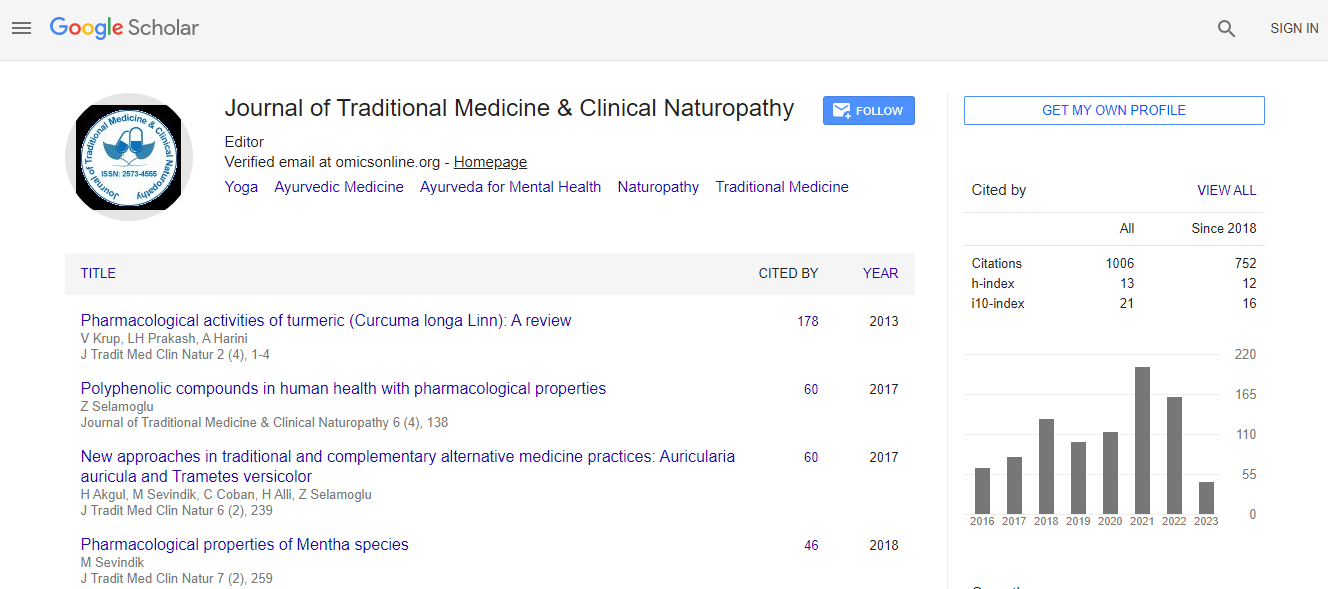Our Group organises 3000+ Global Conferenceseries Events every year across USA, Europe & Asia with support from 1000 more scientific Societies and Publishes 700+ Open Access Journals which contains over 50000 eminent personalities, reputed scientists as editorial board members.
Open Access Journals gaining more Readers and Citations
700 Journals and 15,000,000 Readers Each Journal is getting 25,000+ Readers
Google Scholar citation report
Citations : 1504
Journal of Traditional Medicine & Clinical Naturopathy peer review process verified at publons
Indexed In
- CAS Source Index (CASSI)
- Google Scholar
- Sherpa Romeo
- Open J Gate
- Genamics JournalSeek
- RefSeek
- Directory of Research Journal Indexing (DRJI)
- Hamdard University
- EBSCO A-Z
- Publons
- Geneva Foundation for Medical Education and Research
- Euro Pub
- ICMJE
Useful Links
Recommended Journals
Related Subjects
Share This Page
The potential protective effect of both honey and olive oil against the methotrexate induced hepatotoxicity in rats: Biochemical, histological and immunohistological study
International Conference on Herbal & Traditional Medicine
Hani Abdulfattah AL-Turkistani
King Abdulaziz University, Saudi Arabia
Posters & Accepted Abstracts: J Tradit Med Clin Natur
Abstract
Background: Both honey and olive oil are natural products that are exhibited a good reputation not only because of their high nutritional values but also for their therapeutic properties. A lot of cytotoxic drugs are widely used in the treatment of different types of malignancies, which targeting the proliferation ability of the tumor cells. However, their use leads to injury of the normal cells. Among these drugs is the methotrexate (MTX), which is used in the treatment of a wide range of malignancies and autoimmune diseases. However, it produces many side effects that may even threaten the patient's life e.g. hepatotoxicity. The aim of the work: Is to evaluate the potential effectiveness of single and combined administration of honey and olive oil in the protection from the MTX-induced hepatotoxicity in rats.Method: Eighty four adult male albino rats were used in the present study. They were divided into 7 equal groups; group I was a negative control group, group II was given freshly prepared honey orally by gavage daily at a dose of 1.2 g/kg b.wt, group III was given olive oil (2 ml/day), group IV was given a single intraperitoneal injection of MTX (20 mg/kg bwt), group V was given MTX + freshly prepared honey orally, group VI was given MTX as above + olive oil, group VII was given MTX as above + honey + olive oil. At the end of the experiment (3 weeks), the rats of different groups were sacrificed and blood samples were collected for the determination of the liver function parameters (liver enzymes, protein profile and bilirubin). Then, the abdomen of rats of different groups was opened where pieces of the liver were excised. Half of these pieces were homogized to measure the oxidative (malondialdehyde [MDA]) and antioxidative parametes (superoxide dismutase [SOD], Catalase [CAT] and glutathione peroxidase [GP-x]); while the other pieces were processed for different histological and immunohistochemical techniques.
Result: Administration of honey and olive oil exerted a protective effect against MTX-induced hepatotoxicity as demonstrated by normalization of the liver enzymes, proteins and total bilirubin and histopathological and immunohistological changes observed in the liver. In addition, both agents also reverse the oxidative damage of the liver by decresing MDA level and increasing activities of the antioxidant enzymes in the liver homogenates, as compared with control rats. These effects were more evident when the two agents were given together.
Conclusion: These results provide new evidences of the hepatoprotective effect of combined intake of honey and olive oil on the biochemical and structrural MTX-induced liver damage indicating synergistic effect between them. Consequently, coadministration of these agents might be an effective aduvant therapy in cancerous patients given chemotherapy to alleviate its side effects. Furthermore, we believe that the outcome of this study will represent an important opportunity to get use of these valuable natural products, which were mentioned in many holy Quranic verses.
Biography
Bachelor of Science degree in microbiology: College of Applied of Sciences, Umm Al- Qura University, Makkah 2003 . Master of Science (MS) in Technical Anatomy & Histology Faculty of Medicine, King Abdul-Aziz University, Jeddah . Now in the final stage of the study of the Faculty of Science King Abdulaziz University2018. Publications include: Publication of an article ,The Museum of Anatomy ,World of Words Magazine , University of Toronto , Toronto ,Canada . 2015 :Alturkistani HA1, Tashkandi FM, Mohammedsaleh ZM (2015) Histological Stains: A Literature Review and Case Study , Pup Med , US National Library of Medicine National Institutes of Health. He also work as a supervisor in the anatomy department of King Abdulaziz University, Jeddah, Saudi Arabia
E-mail: halturkistani0003@stu.kau.edu.sa

 Spanish
Spanish  Chinese
Chinese  Russian
Russian  German
German  French
French  Japanese
Japanese  Portuguese
Portuguese  Hindi
Hindi 
